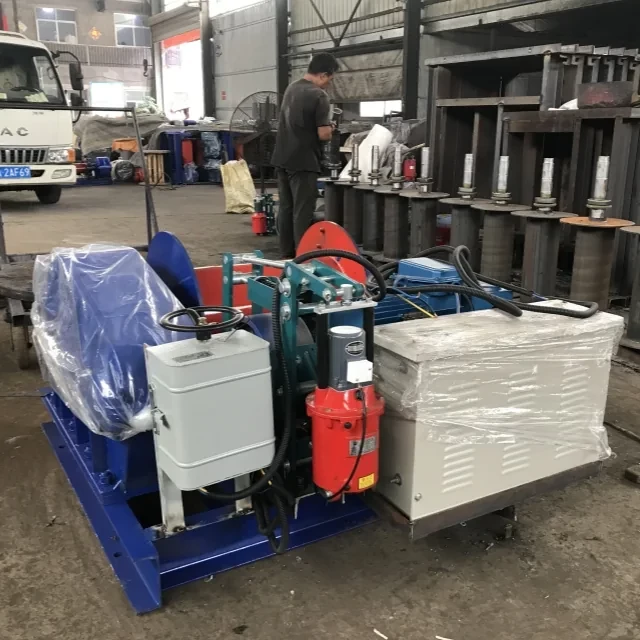When selecting a winch, most buyers focus on motor power or cable strength—but the drum diameter is equally critical. This often-overlooked component dictates load capacity, cable lifespan, and operational efficiency. Whether you're hauling heavy machinery on a construction site or securing marine vessels, understanding drum sizing ensures you avoid costly mismatches between equipment and task demands.
Winch Drum Dynamics: Size Matters Beyond Proportion
The Physics of Drum Diameter and Load Capacity
A winch drum isn’t just a spool for cable storage; it’s a load-bearing engine. Larger diameters reduce the tension on individual cable wraps by distributing weight across a broader surface. Think of it like bending a straw: a tighter curve (smaller drum) strains the material more than a gentle bend (larger drum).
Key mechanical advantages of larger drums:
- Higher load tolerance: The drum’s curvature directly affects how much weight the cable can handle without deformation.
- Reduced internal friction: Fewer tight bends mean less heat buildup and wear on the cable’s core strands.
Ever wondered why industrial winches for mining or shipyards have massive drums? It’s not just for extra cable—it’s physics in action.
How Drum Size Affects Cable Longevity and Efficiency
Smaller drums force cables into tighter coils, accelerating metal fatigue. Studies show that cables wound around drums with diameters less than 20x the cable’s own diameter can lose up to 30% of their service life. For example:
- Optimal ratio: A 10mm cable should spool around a drum ≥200mm in diameter.
- Real-world impact: Offshore rigs using undersized drums report 2x more cable replacements annually than those with properly sized systems.
A Garlway winch designed for construction, for instance, balances drum size with reinforced alloys to prevent premature cable failure—a cost-saving feature for heavy-duty users.
Selecting the Right Winch: Drum Diameter in Practical Contexts
Industrial Use Cases: Marine, Construction, and Mining
-
Marine Applications:
- Challenge: Saltwater corrosion + dynamic loads from waves.
- Solution: Larger drums (e.g., 400mm+) minimize frequent re-spooling, reducing exposure to corrosive elements.
-
Mining Vertical Loads:
- Challenge: Constant heavy lifting with minimal downtime.
- Solution: Drums with diameters exceeding 500mm handle high-tensile cables safely, even at depths of 1,000+ meters.
Did you know a 10% increase in drum diameter can lower energy consumption by up to 7% in continuous operations?
Balancing Drum Size with Portability and Power
While bigger drums excel in heavy industries, mobile units (e.g., off-road recovery winches) prioritize compactness. Here’s the trade-off:
- Compact winches: Smaller drums (150–250mm) save space but require more frequent cable inspections.
- Mitigation strategy: Synthetic ropes (lighter and more flexible than steel) pair better with smaller drums, as seen in Garlway’s portable models.
Conclusion: Matching Drum Size to Your Needs
Choosing a winch drum isn’t about “bigger is better”—it’s about aligning engineering principles with your workload. For industrial users, prioritize diameter-to-cable ratios that extend equipment life. For mobility-focused tasks, explore materials that compensate for smaller spools.
Actionable tip: Before purchasing, calculate your cable’s minimum bending radius (typically 15–20x its diameter) and cross-check it against the drum specs. Brands like Garlway offer sizing guides to simplify this process, ensuring you invest in machinery that performs—and endures.
Related Products
- Best 18000 Pound Drum Anchor Trailer Winch
- Ready Mixer Machine for Construction Ready Mix Machinery
- Warn Winch Windlass Boat Trailer Winch
- Commercial Construction Mixer Machine for Soil Cement Mixing Concrete
- Electric and Hydraulic Winch for Heavy Duty Applications
Related Articles
- How JK Winch’s Electromagnetic Braking System Redefines Heavy-Duty Safety
- How to Choose the Right Trailer-Mounted Winch for Your Industry Needs
- How Anchor Winch Technology Transforms Fishing Efficiency Through Smart Relocation
- How Trailer-Mounted Winches Transform Mobile Operations Across Industries
- How Trailer-Mounted Winches Cut Costs by Replacing Auxiliary Equipment

















